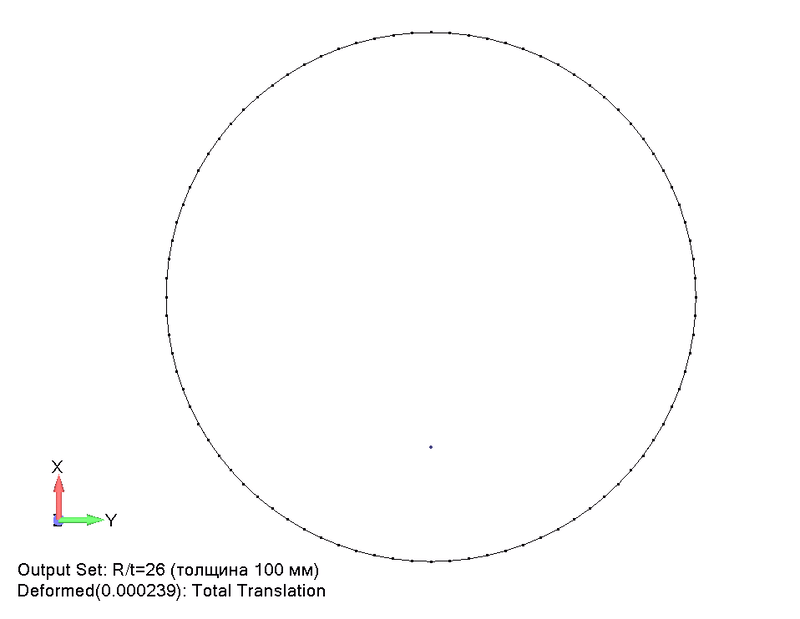Hello,
I have a few questions regarding the negative terms on the factor diagonal error when launching an analysis on nastran.
My problem:
[tt]*** SYSTEM INFORMATION MESSAGE 4159 (DFMSA)
THE DECOMPOSITION OF KLL YIELDS A MAXIMUM MATRIX-TO-FACTOR-DIAGONAL RATIO OF 1.247295E+05
*** USER WARNING MESSAGE 4698 (DCMPD)
STATISTICS FOR DECOMPOSITION OF MATRIX KLL.
THE FOLLOWING DEGREES OF FREEDOM HAVE FACTOR DIAGONAL RATIOS GREATER THAN
1.000000+200 OR HAVE NEGATIVE TERMS ON THE FACTOR DIAGONAL.
USER INFORMATION:
GRID POINT ID DEGREE OF FREEDOM MATRIX/FACTOR DIAGONAL RATIO MATRIX DIAGONAL
20019 T2 8.28362E-01 -1.74108E+02
20019 T3 2.23246E-01 -5.61770E+01
20020 T1 -2.46866E+01 4.15088E+02
20020 T2 -4.31962E+00 -7.86122E+01
20020 T3 -2.85832E-01 -1.50575E+02
20021 T2 -3.20852E-01 1.43679E+01
20021 T3 9.61730E-01 -2.49802E+02
20022 T3 1.23418E+00 -3.57038E+02
20023 T3 -4.48815E+00 -4.75721E+02
20024 T3 -3.79101E-01 -6.09658E+02
20025 T2 -4.82163E+00 4.21503E+02
20025 T3 -8.72780E-01 -7.63142E+02
20026 T3 -5.12149E+00 -9.41100E+02
20027 T3 -1.90611E+00 -1.14923E+03
20028 T2 -1.08507E+00 7.69955E+02
20028 T3 2.15322E+00 -1.26161E+03
20029 T3 -3.54330E+00 -1.14923E+03
20030 T2 -5.65539E+00 5.48362E+02
20030 T3 -4.07993E-01 -9.41102E+02
20031 T3 2.16420E+00 -7.63150E+02
20032 T3 2.03869E+00 -6.09663E+02
Multiple nodes like this, all regarding to the same material[/tt]
As you can see, i set the MAXRATIO value to absurds values until I noticed the problem was not the maxratio, but that i had negative terms. Is there a way to solve this?
I read that negative terms mean this material is buckling, in such case, I guess my analysis is failing and the material is not stiff enough in comparison with the rest of materials? (I'm comparing PVC foam with aluminium.
Thank you very much
I have a few questions regarding the negative terms on the factor diagonal error when launching an analysis on nastran.
My problem:
[tt]*** SYSTEM INFORMATION MESSAGE 4159 (DFMSA)
THE DECOMPOSITION OF KLL YIELDS A MAXIMUM MATRIX-TO-FACTOR-DIAGONAL RATIO OF 1.247295E+05
*** USER WARNING MESSAGE 4698 (DCMPD)
STATISTICS FOR DECOMPOSITION OF MATRIX KLL.
THE FOLLOWING DEGREES OF FREEDOM HAVE FACTOR DIAGONAL RATIOS GREATER THAN
1.000000+200 OR HAVE NEGATIVE TERMS ON THE FACTOR DIAGONAL.
USER INFORMATION:
GRID POINT ID DEGREE OF FREEDOM MATRIX/FACTOR DIAGONAL RATIO MATRIX DIAGONAL
20019 T2 8.28362E-01 -1.74108E+02
20019 T3 2.23246E-01 -5.61770E+01
20020 T1 -2.46866E+01 4.15088E+02
20020 T2 -4.31962E+00 -7.86122E+01
20020 T3 -2.85832E-01 -1.50575E+02
20021 T2 -3.20852E-01 1.43679E+01
20021 T3 9.61730E-01 -2.49802E+02
20022 T3 1.23418E+00 -3.57038E+02
20023 T3 -4.48815E+00 -4.75721E+02
20024 T3 -3.79101E-01 -6.09658E+02
20025 T2 -4.82163E+00 4.21503E+02
20025 T3 -8.72780E-01 -7.63142E+02
20026 T3 -5.12149E+00 -9.41100E+02
20027 T3 -1.90611E+00 -1.14923E+03
20028 T2 -1.08507E+00 7.69955E+02
20028 T3 2.15322E+00 -1.26161E+03
20029 T3 -3.54330E+00 -1.14923E+03
20030 T2 -5.65539E+00 5.48362E+02
20030 T3 -4.07993E-01 -9.41102E+02
20031 T3 2.16420E+00 -7.63150E+02
20032 T3 2.03869E+00 -6.09663E+02
Multiple nodes like this, all regarding to the same material[/tt]
As you can see, i set the MAXRATIO value to absurds values until I noticed the problem was not the maxratio, but that i had negative terms. Is there a way to solve this?
I read that negative terms mean this material is buckling, in such case, I guess my analysis is failing and the material is not stiff enough in comparison with the rest of materials? (I'm comparing PVC foam with aluminium.
Thank you very much

